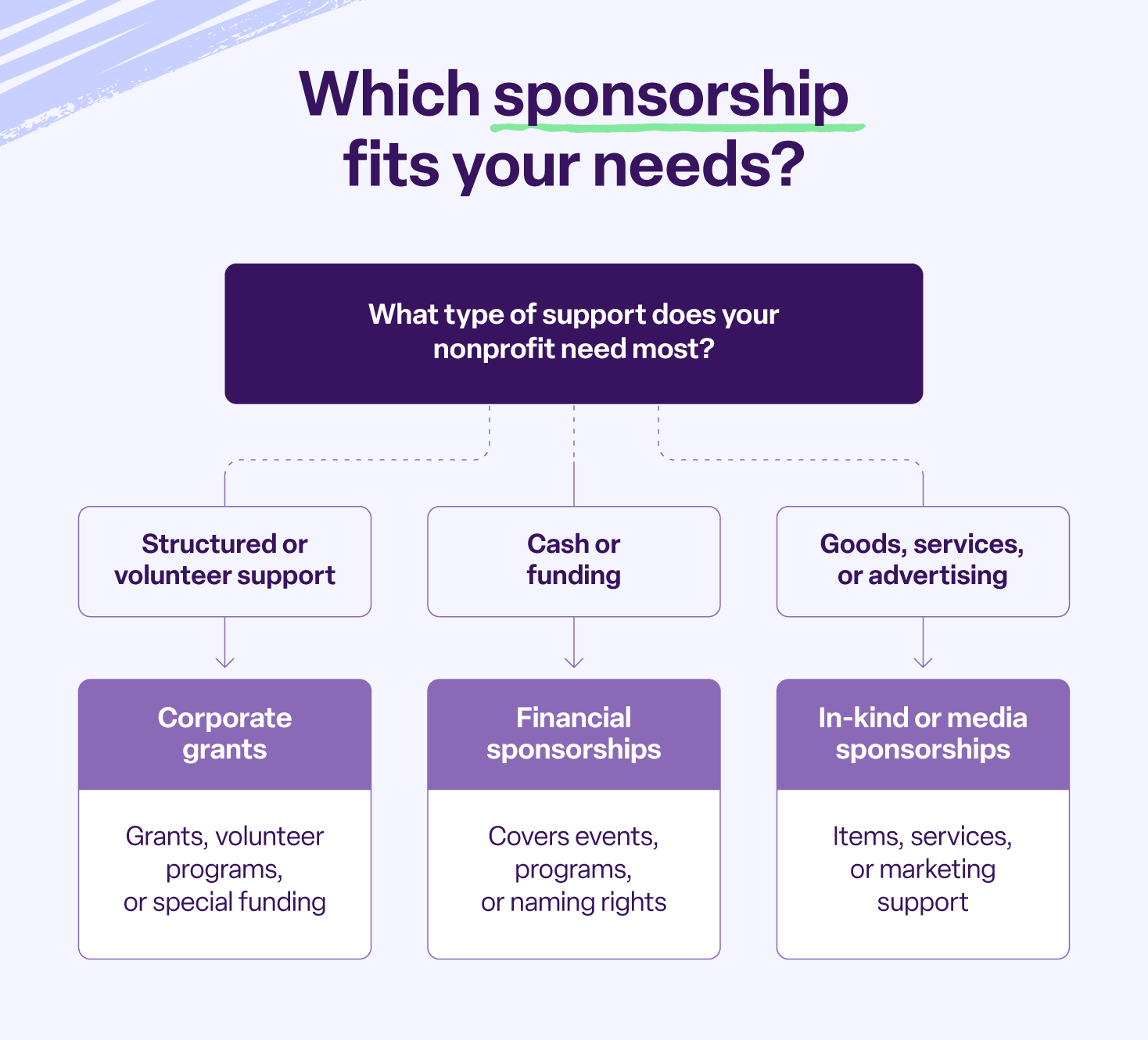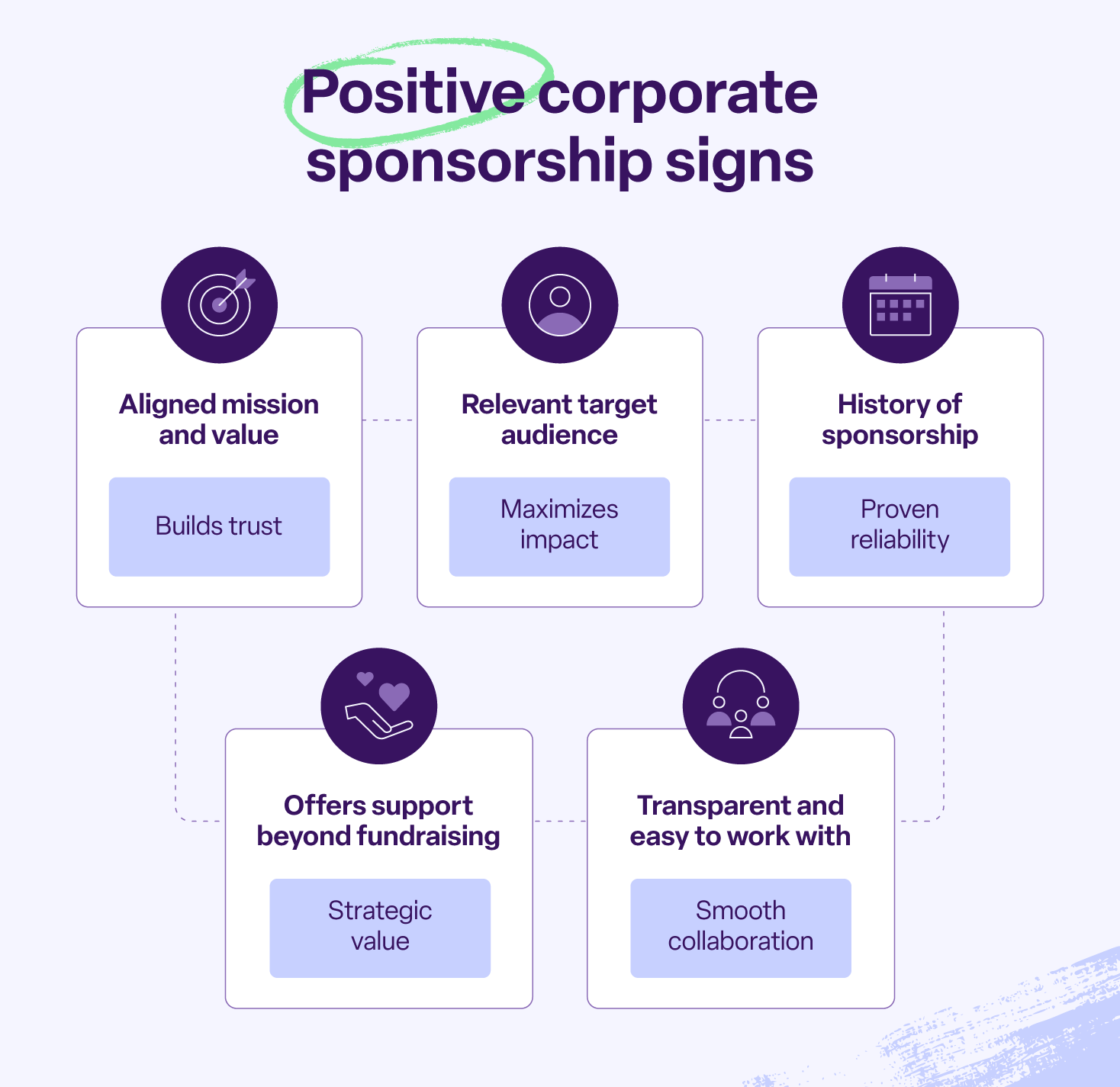How to get corporate sponsors for your event: 4 simple steps

When your nonprofit organization develops a fundraising strategy, you likely consider individual donations, event revenue, and grants as your main funding sources. However, these may not be enough, which is why it’s important to look into how to get sponsorships.
These are a highly profitable revenue source that can help fund a variety of specific, high-value initiatives. Corporate sponsors can lend your event more reach, recognition, and legitimacy in the eyes of a potential attendee or donor.
This guide will help you understand and secure the most common type of nonprofit sponsorship: that of a for-profit corporation. Let’s get started.
What is a sponsorship?
A nonprofit sponsorship is a mutually beneficial partnership between a nonprofit and another party. In a corporate sponsorship, your nonprofit receives financial support or in-kind contributions from a business, and the sponsor receives increased brand visibility from your organization in return.
Large corporations might sponsor a nonprofit as part of their corporate philanthropy programs. For example, Microsoft has sponsored Code.org to help promote and fund computer science education.
Smaller businesses often partner with nonprofits to build connections and improve their local community. For instance, a local coffee shop might decide to sponsor a nonprofit’s fundraising race. Both organizations get exposure to each other’s audience and bring in more funds together.
Types of sponsorships
There are several types of corporate sponsorships your nonprofit could add to its fundraising strategy. To help you determine which would be best for your organization, let’s look at the four most common types in more detail.

Financial sponsorships
This type of sponsorship is fairly straightforward: A business provides financial sponsorship to a nonprofit, usually for a specific purpose. Although event fundraisers can bring in significant revenue, they come with upfront costs. Sponsors can cover some of those expenses, and you can easily thank them by featuring their logos in your event marketing materials.
You can also secure financial contributions outside of events by offering naming rights to corporations. Put your sponsor’s name on a space inside your organization’s facilities in exchange for a one-time or recurring donation.
If you have several rooms or wings that could be named, create sponsorship tiers so businesses can choose to contribute larger amounts to acquire the naming rights to a more prominent space.
In-kind donations
In some cases, a business might be willing to donate physical items or services to a nonprofit instead of making a financial contribution. Some examples of this might include:
- A grocery store contributing snacks and water bottles for walk-a-thon participants
- A travel company offering a vacation package as an auction item
- A restaurant catering a major donor appreciation dinner for free
Depending on your organization’s needs, an in-kind sponsorship may be more valuable than a financial sponsorship. Instead of asking a business for money and then devoting more time to making purchases, you’ll receive the necessary items upfront.
However, in-kind sponsorships can also be less flexible, so negotiate the agreement carefully to maximize the business’s support.
Media sponsorships
Media sponsorships are a type of in-kind contribution that provide free advertising rather than physical items or financial support.
In many cases, media sponsorships involve co-advertising, in which the corporation names an official nonprofit partner and creates print and digital advertisements featuring your logo alongside theirs. Some television networks and radio stations also offer free advertising space to nonprofits as a form of media sponsorship.
Corporate grants
Private foundations and government entities aren’t the only organizations that offer nonprofit grants. Many businesses provide one of three different types of grant funding as well:
- Traditional grants: Some large corporations have associated foundations that offer traditionally formatted grants. Your organization will have to submit an application tailored to the foundation’s requirements to be considered for funding.
- Volunteer grants: If your nonprofit relies on volunteers, you can bring in additional revenue through a volunteer grant, where businesses donate when their employees volunteer, maximizing your volunteers’ value while boosting employee engagement.
You can also find specialized grants, like the Google Ad Grant. This program bridges the corporate grant and media sponsorship categories. It requires an application, but the process isn’t competitive. Any eligible organization can receive a monthly advertising stipend from Google, providing valuable brand exposure and added flexibility in your organization’s marketing budget.
These corporate sponsorships are beneficial for everyone involved. Your nonprofit receives the funding it needs to run a successful event, while the corporate sponsor receives a charitable reputation boost and gets introduced to your guests.
5 steps for recruiting corporate sponsors
The right corporate sponsor can help boost your nonprofit’s brand credibility and recognition. Here are some helpful strategies to acquire their support:

1. Research corporate sponsor prospects
Before you can build relationships with corporate sponsors, you have to know who they are. Conduct prospect research to identify high-value candidates and gather information about their backgrounds, preferences, and motivations, which you can then use to make an effective appeal.
Follow these steps for successful prospect research:
- Evaluate your donor database: Chances are you already have donors in your database whose companies would be willing to lend their support. Narrow down the data in your nonprofit CRM to focus on capacity (wealth) markers that show a person’s business affiliates and affinity to contribute.
- Ask for referrals: Leverage your board’s personal connections and contacts to find the right sponsor, then ask your board members to contact the company directly by signing a proposal letter and making a follow-up phone call.
- Hire a consultant: If you don’t have the time or resources to conduct in-house prospect research, outsource the work to a fundraising consultant who specializes in corporate sponsorships. Their job is to screen databases for prospects and support your event’s planning and execution.
- Consider your peers: Look at other nonprofits in your community. Which companies are sponsoring their events? Who are the competitors of those companies? It also helps to check out event pages and websites to find out what kind of publicity your peers are giving their sponsors so you can offer equivalent opportunities to your potential sponsors.
Prospecting allows you to focus your efforts on donors with the highest likelihood of sponsoring your event. Once you have a better understanding of who these prospects are, you can move on to proposing a partnership.
2. Define your target audience
To secure the support of a corporate sponsor, you’ll need to prove that your objectives align. One way to do this is to demonstrate how your supporters and their potential customer bases overlap. Even partnerships with little in common can benefit if their target demographics match.
Begin by gathering the following information about your supporters:
- Demographics, such as age, education, geography, and income
- Average event turnout and participation rate from previous fundraising campaigns
- Size of your reach through email, social media, and direct mail
Then, determine your potential sponsor’s target market. Use similarities to make a strong case for banding together. For example, an insurance company with a target customer base of people aged 65 and older would be the ideal partner for a nonprofit event expecting the attendance of elderly donors and their families.
Communicate your findings to the company and include the percentage of past event attendees that fall into this target demographic.
3. Incentivize corporate sponsors
If you want to win over a sponsor, you need to prove that their return on investment (ROI) will be worth it. Formulate your approach with one question in mind: What’s in it for the sponsor?
For most corporate sponsors, the idea of getting the word out and expanding their reach is enough of an incentive to form a partnership. However, some corporations might want VIP tickets to your event, while others want their company’s name to be mentioned in a press release.
Tailor your incentives to the unique needs of your prospective partner, using these ideas to get you started:
- Build a dedicated sponsor page on your nonprofit’s website describing their company and linking to their site.
- Recognize their support in board meetings, press interviews, and public speeches.
- Create a personalized video about your sponsor and post it on social media.
- Allow the sponsor to write a series of guest blog posts on your website.
- Include your sponsor’s logo and messaging in email, direct mail, and social media outreach used to promote the event.
- Invite them for a private tour of the event venue and arrange for the press to take photos.
When you approach prospective sponsors, listen more than you talk, and ask them about their goals and priorities. That way, you’ll know exactly which benefits will appeal to them.
4. Write a corporate sponsorship proposal letter
With all this background information, you’re ready to formulate a compelling proposal. Corporate sponsorship letters contain all the information a prospective sponsor needs. From highlighting your accomplishments to introducing new partnership opportunities, this is your chance to win over your next corporate sponsor.
When it comes time to write your letter, be sure to:
- Describe the event: Include specifics about the event and introduce an intended goal. For instance, you could say, “We are excited to present our plans for this 5k walk. With the help of your valued contribution, we aim to raise $25,000 for cancer research.”
- Present your target audience: Use your previous findings to provide an in-depth look at how your target demographics overlap. Consider this example: “We understand that your customers are primarily young adults and college students. At our last benefit concert, 92% of the participants were aged 18-24.”
- Suggest sponsorship packages: Describe what you’re looking for in a sponsorship, whether it be in-kind donations or financial contributions. Then, explain what you will give sponsors in return. For instance, in return for a $5,000 sponsorship, you will mention their company in a speech, display their logo on event programs, and tag their social media accounts on related posts.
5. Follow up and build lasting partnerships
After you send out the proposal letter, follow up to see if they have any additional questions and gauge their interest in the partnership. Be sure to thank them for their consideration, regardless of their decision, so they’re left with a positive impression of your organization.
Once your sponsors have agreed to support you, follow up with a contract and involve the sponsor in planning and promotion so they feel like an integral part of your event and so your event feels like part of their overall outreach strategy.
Benefits of nonprofit sponsorships
There are several benefits of using nonprofit sponsorships for both your nonprofit and the sponsoring company. These benefits include:
- Financial support, either through direct funding or from in-kind donations, that provide the ability to reduce service, event planning, and marketing costs
- Increased promotion of your purpose to help spread awareness
- New supporters from the sponsor’s customer base
- Brand credibility due to your connection with a well-established business
Corporations also benefit from sponsorships because their name becomes associated with a charitable cause, which helps improve their reputation. They can also attract new customers from your supporter base and receive tax deductions for working with a charitable organization. When approaching a potential corporate sponsor, make sure to emphasize these perks to show that the sponsorship will be mutually beneficial.
Build lasting sponsorships with Bonterra
Strengthening nonprofit partnerships is a key part of increasing funds and furthering your organization’s mission. But to do this well, you need to know how to get sponsorships. Do your research so you can find the right sponsors for your organization. Remember to thank your sponsors, because a sponsor who feels appreciated will be more eager to keep supporting your organization long term.
Bonterra’s software makes this process easier by letting you centralize donors and contacts in one place, track communication, and highlight companies that align with your mission and goals. Plus, you can get data-driven insights into the success of your outreach and the impact of your sponsorships, allowing you to make improvements and changes as needed.

FAQ
How do I find sponsorships?
Seek out companies with values that align with your nonprofit’s mission. Look into local businesses (especially those with corporate social responsibility programs) and online databases of corporate giving opportunities. You can also meet potential sponsors at networking events or through industry contacts.
What is a corporate sponsorship?
A corporate sponsorship is a partnership between a corporation and another party, often a nonprofit organization. The corporation provides financial support to the nonprofit while the nonprofit organization helps increase the company’s brand visibility and reach.
How do I request a sponsorship?
To request a sponsorship, write a clear proposal outlining the pertinent information, including your nonprofit’s mission, the program or event you’re planning, and the benefits for the sponsor. Then send your sponsorship letter or reach out via phone or connect in person.
Can I ask a brand to sponsor me?
Yes, companies often welcome sponsorship requests. Do your research to ensure your goals and values align, then approach them thoughtfully and be sure to explain the mutual benefits.
Work with Bonterra



